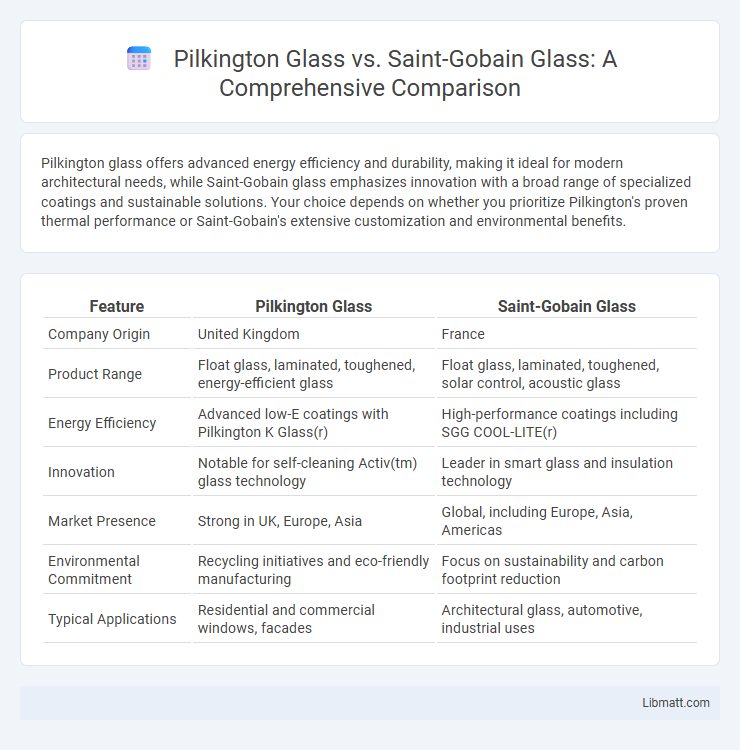Pilkington glass offers advanced energy efficiency and durability, making it ideal for modern architectural needs, while Saint-Gobain glass emphasizes innovation with a broad range of specialized coatings and sustainable solutions. Your choice depends on whether you prioritize Pilkington's proven thermal performance or Saint-Gobain's extensive customization and environmental benefits.
Table of Comparison
| Feature | Pilkington Glass | Saint-Gobain Glass |
|---|---|---|
| Company Origin | United Kingdom | France |
| Product Range | Float glass, laminated, toughened, energy-efficient glass | Float glass, laminated, toughened, solar control, acoustic glass |
| Energy Efficiency | Advanced low-E coatings with Pilkington K Glass(r) | High-performance coatings including SGG COOL-LITE(r) |
| Innovation | Notable for self-cleaning Activ(tm) glass technology | Leader in smart glass and insulation technology |
| Market Presence | Strong in UK, Europe, Asia | Global, including Europe, Asia, Americas |
| Environmental Commitment | Recycling initiatives and eco-friendly manufacturing | Focus on sustainability and carbon footprint reduction |
| Typical Applications | Residential and commercial windows, facades | Architectural glass, automotive, industrial uses |
Introduction to Pilkington Glass and Saint-Gobain Glass
Pilkington Glass, a key player in the global glass manufacturing industry, is renowned for its innovation in architectural and automotive glass solutions, offering advanced products like energy-efficient and safety glass. Saint-Gobain Glass, part of the Saint-Gobain Group, excels in producing high-performance glass products that emphasize sustainability and cutting-edge technology across construction, automotive, and industrial markets. Both companies lead in quality and technological advancements, driving the evolution of glass materials worldwide.
Company Backgrounds: Pilkington vs Saint-Gobain
Pilkington, founded in 1826 in the UK, is renowned for pioneering float glass technology and operates as a leading subsidiary of Nippon Sheet Glass. Saint-Gobain, established in 1665 in France, is a global leader in sustainable building materials and glass manufacturing, serving multiple industries including construction and automotive. Your choice between these glass suppliers depends on whether you prioritize Pilkington's heritage in innovative glass solutions or Saint-Gobain's extensive product range and sustainability focus.
Product Range Comparison
Pilkington glass offers a comprehensive product range that includes energy-efficient glazing, acoustic control glass, and safety solutions, catering to both residential and commercial markets. Saint-Gobain glass specializes in advanced architectural and automotive glass innovations, featuring solar control, low-emissivity coatings, and smart glass technology for enhanced performance. Both companies provide customized glazing solutions, but Saint-Gobain places a stronger emphasis on sustainable and high-performance glass tailored to modern construction demands.
Glass Quality Assessment
Pilkington glass is renowned for its high clarity and uniform thickness, resulting from advanced float glass manufacturing technology, which enhances optical quality and reduces distortions. Saint-Gobain glass offers superior thermal performance and durability, incorporating innovative coatings and laminated structures to improve energy efficiency and safety standards. Both brands undergo rigorous quality assessment processes including surface inspections, impact resistance testing, and light transmission analysis to ensure top-tier glass performance for architectural and automotive applications.
Energy Efficiency and Thermal Performance
Pilkington glass offers advanced energy efficiency with its range of low-emissivity coatings that reduce heat loss and improve thermal insulation, ideal for maintaining consistent indoor temperatures. Saint-Gobain glass specializes in high-performance glazing solutions that enhance thermal comfort by minimizing solar heat gain and maximizing natural light transmission, contributing to lower energy consumption. Your choice between Pilkington and Saint-Gobain should consider specific climate conditions and insulation needs to optimize energy savings and thermal performance.
Safety and Security Features
Pilkington glass offers advanced safety and security features such as laminated and toughened glass options designed to resist impact and prevent shattering. Saint-Gobain glass incorporates similar protective technologies, including multi-layered laminated glass with enhanced ballistic resistance and fire protection capabilities. You can choose either brand for reliable solutions that enhance safety and security in residential or commercial applications.
Design and Customization Options
Pilkington glass offers a wide range of design and customization options, including decorative patterns, tinted colors, and textured finishes tailored for architectural and automotive applications. Saint-Gobain glass provides advanced customization features such as low-emissivity coatings, laminated safety layers, and energy-efficient glazing solutions designed to meet specific thermal and acoustic performance requirements. Both brands prioritize innovation and aesthetic versatility, allowing architects and designers to achieve unique visual effects while enhancing building performance.
Environmental Impact and Sustainability
Pilkington glass emphasizes energy-efficient production with a focus on reducing carbon emissions and increasing recycled content, supporting sustainable building practices. Saint-Gobain glass incorporates advanced eco-friendly technologies such as solar control coatings and enhanced thermal insulation to minimize environmental impact throughout the product lifecycle. When choosing your glass solutions, considering these companies' commitments to sustainability can help reduce your ecological footprint in construction projects.
Market Presence and Availability
Pilkington glass, established under the NSG Group, maintains a strong market presence across Europe and Asia, offering wide availability through extensive distribution networks and partnerships with construction and automotive industries. Saint-Gobain glass, a global leader headquartered in France, boasts a dominant position in North America, Europe, and Asia with a vast portfolio of specialty and architectural glass products readily accessible worldwide. Both companies leverage advanced logistics and local manufacturing facilities to ensure consistent supply and quick delivery to meet diverse market demands.
Price Comparison and Value for Money
Pilkington glass generally offers competitive pricing with a strong reputation for durable and energy-efficient glass solutions, making it a cost-effective option for various applications. Saint-Gobain glass tends to be priced slightly higher but justifies the premium through advanced technology, superior performance, and innovative features that enhance long-term value. Your choice depends on balancing upfront costs with desired quality and efficiency, where Pilkington provides solid value and Saint-Gobain delivers enhanced benefits for specific needs.
Pilkington glass vs Saint-Gobain glass Infographic

 libmatt.com
libmatt.com